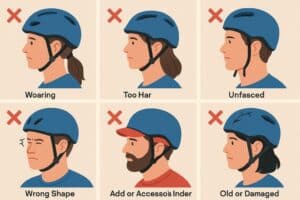Helmets are one of the most effective tools for preventing serious head injuries during biking, motorcycling, or other recreational activities. However, simply wearing a helmet is not enough. The Parnall Law legal team has seen firsthand how improper helmet use can worsen the outcome of an accident. If it doesn’t fit properly, the protection it provides can be greatly reduced, leaving you vulnerable in the event of an accident. Understanding common helmet fit mistakes can help you stay safer on the road or trail.
Wearing the Wrong Size
A helmet that is too big or too small is one of the most frequent mistakes. A helmet that’s too loose can shift around or even come off during impact, while one that’s too tight can create pressure points and discomfort, making it less likely you’ll wear it consistently. The right size should feel snug without causing pain, and it should remain in place even when you shake your head.
Positioning It Too High or Too Low
Even with the correct size, placement matters. Wearing a helmet too far back on your head leaves your forehead exposed, while positioning it too low can obstruct your vision. The front edge of the helmet should rest about one to two finger-widths above your eyebrows, providing a balance between protection and visibility.
Neglecting the Chin Strap
Many riders underestimate the role of the chin strap in overall safety. A loose or unclipped strap renders the helmet almost useless, as it may fly off in a crash. The strap should form a snug “V” shape under your ears and be tight enough that only one or two fingers fit between the strap and your chin.
Ignoring Helmet Shape
Not all helmets are designed the same way, and head shapes differ as well. Some helmets are more oval, while others are round. If you pick a helmet that doesn’t match your head shape, it can create gaps or uncomfortable pressure points, compromising both comfort and protection. Trying on different styles and brands is the best way to find a proper fit.
Forgetting to Adjust Internal Padding
Most helmets come with removable or adjustable padding inside. Failing to make these adjustments can result in gaps that compromise stability. Taking the time to customize the padding not only improves comfort but also ensures the helmet stays firmly in place when it matters most.
Wearing Hats or Accessories Under the Helmet
It may be tempting to wear a baseball cap, a thick beanie, or other accessories under your helmet, but doing so can compromise the fit. This creates space that weakens the helmet’s protective ability. If warmth is a concern, look for thin, helmet-specific liners that won’t compromise safety.
Using Old or Damaged Helmets
Even if a helmet once fit perfectly, age and wear can affect its protective abilities. Cracks, dents, or worn straps compromise safety, and older helmets may not meet current safety standards. Experts recommend replacing helmets every few years or as soon as possible after any significant impact has occurred.
Not Testing the Fit Properly
Finally, many people simply put a helmet on and assume it fits without testing it. A quick way to check is to fasten the straps and shake your head from side to side and up and down. A properly fitted helmet should stay in place and feel secure, not wobble or slide around.
Conclusion
A helmet can only do its job if it fits correctly, and overlooking even minor details can compromise your safety. By avoiding these common mistakes, you not only increase your level of protection but also improve comfort, making it more likely you’ll wear your helmet every time. The Parnall Law legal team often works with individuals who have suffered serious injuries because of faulty or ill-fitting safety gear. If you or a loved one has suffered a head injury due to a defective or improperly fitted helmet, it may be time to talk to a lawyer who can explain your options.
